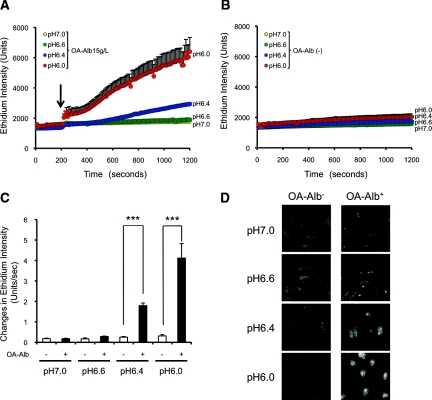Figure 1.
An acidic environment increases OA-Alb–induced superoxide (O2·−) production. HK-2 cells were incubated in HBSSH/l-arginine at a physiologically relevant pH (pH 7.0 to pH 6.0) with or without OA-Alb stimulation (15 g/L). O2·− production was assayed using the O2·−-specific fluorescence probe, DHE. (A) OA-Alb, administered at 200 seconds after DHE (10 μM) loading (arrow) led to increased O2·− production at pH 6.0 (red) and pH 6.4 (blue). (B) Acidification without OA-Alb stimulation did not induce O2·− production in HK-2 cells (P = 0.074 among all pH conditions). (C) The O2·− production rate was significantly increased up to 7-fold at pH 6.4, and up to 13-fold at pH 6.0, compared with the OA-Alb− control (***P < 0.001). (D) Representative photomicrographs of HK-2 cells, with or without OA-Alb stimulation at the indicated pH, 1000 seconds after DHE loading, are shown. The white signals indicate O2·− production. All the experiments were repeated at least six times, and data are expressed as the mean ± SEM.

